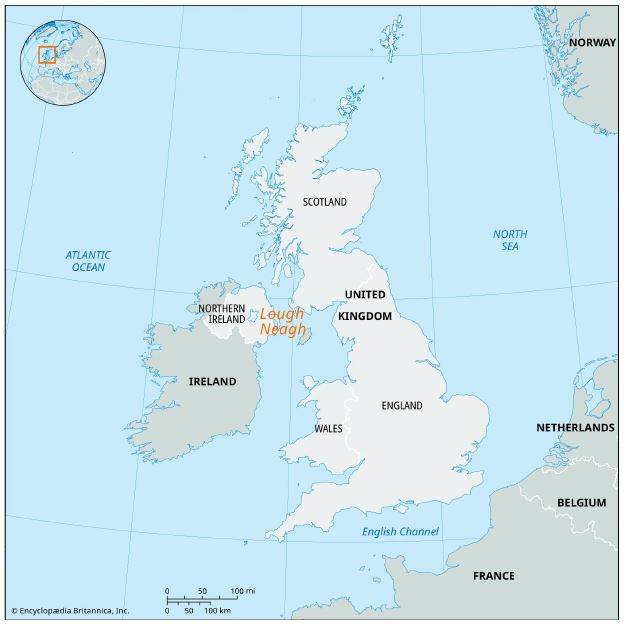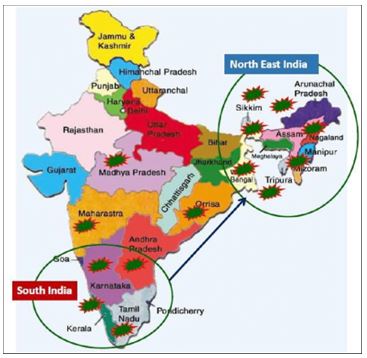International Light Pollution Guidelines
The recently concluded COP-14 to the Convention on the Conservation of Migratory Species and Wild Animals (CMS) held at Uzbekistan has prepared International Light Pollution Guidelines for migratory species.
- Draft resolution – By EU and Australia during CMS COP13 in 2020, where the issue of light pollution 1st emerged.
- Reference materials –‘National Light Pollution Guidelines’ prepared by Australia in 2020.
- Observation at COP-14, CMS – Between 1992 and 2017, artificial light emissions have increased over 49%.
- It noted that natural darkness has conservation value equal to clean water, air and soil.
- Guidelines – Reduce light pollution to minimise its effect on wildlife and undertake environmental impact assessments to understand the impacts on species.
- Avoid lighting in the 20-km radius around wildlife home & light spill, use non-reflective, dark-coloured surfaces and avoid specific colour wavelengths.
- Use best practices in lighting, managing light time, colour and intensity.
Light management in the Gorgon LNG Plant in Australia reduced sky glow and helped long-term marine turtle management.
Impact of Light pollution in Wildlife Species
- Birds – Both marine and terrestrial dwelling birds can be affected by lights from as far as 15 km away.
- It disrupts foraging and make the birds starve.
- Fledgling seabirds may not be able to take their first flight if their nesting habitat never becomes dark.
- It can disorient flying migratory birds, diverting from efficient migratory routes or even collide with infrastructure.
- Migratory shorebirds may avoid roosting sites having more light and increase their vulnerability to predation due to visibility.
- Exposure to white light increases stress hormone corticosterone among free living songbirds, as against green or red light, and thus reduces offspring rate.
- Other lifeforms - Mammals, reptiles and fish are also be affected.
- Tammar wallabies (Macropus eugenii) delays reproduction.
- Clownfish (Amphiprion ocellaris) eggs incubated under constant light do not hatch.
- The hatchlings of marine turtles may be unable to find their way to the ocean if beaches are lit.
- Among bats, roosting, emerging, foraging, swarming, mating, commuting, drinking and migrating is impacted.
Bortle Scale is a 9 level numeric scale that measure the night sky’s brightness at a given location. It ranges from Class 1 (darkest skies) to Class 9 (pale, light-marred skies over the insides of cities).
Reference
Down To Earth| Light Pollution Guidelines for Migratory Species
Maner Sharif Dargah
The local community along with heritage enthusiasts is seeking UNESCO World Heritage Site status to Maner Sharif Dargah to preserve this historical and culturally significant site.
World Heritage Sites are the sites designated as having “outstanding universal value, was adopted by UNESCO in 1972 and formally took effect in 1975. The 3 types of site are Cultural, Natural, and Mixed.
- Maner Sharif Dargah – Maner is a small town in Bihar.
Dargahs are shrines having the graves of Sufi saints. Its unique blend of Indo-Islamic design, speaks volumes of the artistic and cultural achievements. Both Muslims and Hindus go to dargahs and thus it unite all communities.
- Established in – Early 11th century, before the advent of Mughal rule in India.
- It is believed to host the India’s oldest Sufi centre.
- Khanquah – A place dedicated to spiritual practice and religious education, established by Hazrat Imam Mohammad Taj Faqueeh Qureshi Hashmi.
- Architecture – It has a big dome on the top whose ceiling is full of different markings depicted from the Quran.
- 2 Muslim tombs – For Sufi saints.
- Bari Dargah – The great shrine for Hazrat Sultan Ul Makhdoom Shaikh Yahya Maneri
- Chhoti Dargah – The small shrine for Hazrat Makhdoom Shah Daulat Maneri
- Significance – In the mediaeval time, it used to be the principal site of learning and knowledge in the region.
- It is a pulsating hub of faith where Muslims and Hindus converge, united in their quest for solace and spiritual enlightenment.
- Conservation – Currently maintained by the Archaeological Survey of India (ASI), its potential inclusion in the list of World Heritage Sites would bolster efforts to maintain its structural integrity and promote cultural tourism.
India has 42 World Heritage Sites, 6th highest in the World. The 2 World Heritage Sites in Bihar are the Mahabodhi temple at Bodh Gaya and the remains of Nalanda Mahavihara in Nalanda.
References
- BNNBreaking| Efforts to recognise Maner Sharif Dargah
- Incredible India| Maner Sharif Dargah
AFR100 Project
A new study reveals that an area the size of France is threatened by AFR100 initiative due to inappropriate forest restoration in the form of tree-planting.
- AFR100 – The African Forest Landscape Restoration Initiative.
- Launched in – 2015, at COP21 of UNFCCC in Paris.
- Launched by – African Union Development Agency (AUDA-NEPAD), World Resources Institute (WRI), World Bank and Germany’s Federal Ministry for Economic Cooperation and Development (BMZ).
- Secretariat – AUDA-NEPAD.
- Aim – To restore 100 million hectares of land in Africa by 2030 and to accelerate restoration to enhance food security, increase climate change resilience and mitigation, and combat rural poverty.
- Coverage – 34 countries and 130 million hectares as of now.
Forest and Landscape Restoration (FLR), a process of regaining ecological functionality and enhancing human well-being across deforested or degraded forest landscapes. Restoring the whole landscape to meet the present and future needs of people and biodiversity.
- Agroforestry – Mixing trees and shrubs with agricultural crops to improve the productivity and ecological function.
- Assisted natural regeneration – By eliminating barriers and threats to their growth, leaning on local knowledge of the land.
- Mangrove restoration – Regrowing mangroves in coastal ecosystems to protect communities, safeguard biodiversity, and store carbon.
- Reforestation – Planting and maintaining trees across a deforested landscape with little or no remaining forest cover.
- Riparian restoration – Re-establishing vegetation along a river, lake, wetland, or other water body to improve its ecological function.
- Silvopasture – Adding trees to deforested pasture to improve the productivity and health of land managed by pastoralist communities.
- Challenges – Non-forest systems such as savannahs are misclassified as forest and considered for restoration with trees.
- Increased tree cover in these non-forest systems could be a risk to wildlife like rhinos and wildebeest, as well as people who depend on these ecosystems.
References
- ScienceDaily| Reforestation Initiative threatens Grasslands
- AFR100| African Forest Restoration Initiative
Lake Lough Neagh
2024 is the 1st year, to encounter no appearance of Lake Lough Neagh’s fly in the lake, indicating accelerated ecosystem collapse.
- Located in – East-central Northern Ireland.
- It covers an area of approximately 392 square kms with a catchment area of 5,700 square km.
- Water source – Upper River Bann, the River Blackwater, and the River Main, and it is drained northward by the Lower Bann.
- Importance – It is the largest freshwater lake in British Isles.
British Isles, group of islands off the northwestern coast of Europe. It consists of 2 main islands, Great Britain and Ireland, and numerous smaller islands and island groups.
- It supplies more than 40% of Northern Ireland’s drinking water
- It hosts the largest wild eel fishery in Europe.
- Over 100 different bird species can be spotted here throughout the year, including the iconic Arctic Tern and the elusive Brent Goose.
- It is also considered a cultural and archaeological jewel.

- Threat – Long-term pollution, largely from agriculture was a key part of the problem as increased nutrient discharge leads to growth of a vast “bloom” of blue-green algae.
- Along with invasive species like water-clearing zebra mussels, and the weather effects of climate change, the perfect conditions were created for the potentially toxic algae to bloom from the depths where it has always been present.
- Loss of biodiversity – Algal bloom, a thick, photosynthesising blanket deprives the lake of oxygen, choke the aquatic life and thus accelerates biodiversity crisis.
- Decreased numbers of Lough Neagh fly, a crucial insect that support fish, wildfowl, frogs and predatory insects lead to loss of those dependent species as well.
References
- The Guardian| Collapse of UK’s Largest Lake
- BBC| Algal Bloom over Lake Lough Neagh
Revised Sustainable and Inclusive Development of Natural Rubber Sector scheme
The union government has increased the allocation for sustainable development of the natural rubber sector scheme for the next 2 financial years (2024-26) by 23% from Rs 576.41 crore to Rs 708.69 crore.
- Aim – To improve the productivity of natural rubber.
- Implementing agency – Rubber Board.
The Rubber Board, a statutory body constituted under the Rubber Act 1947, for the overall development of the rubber industry in the country. It is under the administrative control of the Ministry of Commerce and Industry with head office in Kottayam, Kerala.
- Fund allocation – In support of plantation, generation of planting material, productivity enhancement, forming of rubber producer’s societies, and rubber research and training.
- Other initiatives – Rubber Board to intensify digitization providing instant services via apps, drones
- 3 nodal Rubber Training Institutes to be formed in Northeast to promote MSMEs.
- Plantation – 12,000 hectares in traditional areas like including Kerala, Karnataka and Tamil Nadu, and 3,752 hectares in non-traditional areas like Andhra Pradesh, Odisha and north-east states.

In FY 2023, Kerala accounted for a major chunk of the production of Rubber in India and imports are made from Vietnam, Malaysia and other Southeast Asian nations.
|
Natural Rubber
|
Synthetic Rubber
|
|
An elastomeric polymer obtained from the latex of the tree, Hevea brasiliensis.
|
A man-made polymer from crude oil by-products through polymerization.
|
|
Properties are difficult to change.
|
Properties can be adjusted.
|
|
Higher tensile strength and tear resistance.
|
Relatively lower tensile strength and tear resistance
|
|
Lower Odour
|
Relatively High odour
|
|
It may have natural protein that are allergic to humans.
|
It may not contain allergens.
|
|
It is used for making surgical gloves, aviation and automotive tyres, clothing, and toys, among other things.
|
It is resistant to the action of petrol, lubricating oil and organic solvents and so used in making oil seals, conveyor belts, gaskets and hoses, etc.
|
References
- The Indian Express| Funding for Development of Rubber
- NCERT| Natural and Synthetic Rubber
- PIB| Development of Natural Rubber in India